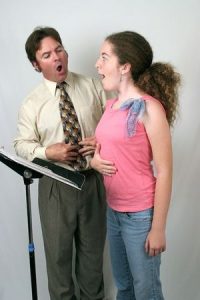When we discuss breathing we must include posture. Without the correct posture for singing breath management is impossible.

Posture is important in singing because it elevates the sternum and ribs, allowing greater lung expansion during the inhale and better control over the extended exhale. If posture is not correct, singers tend to use incorrect muscles to compensate. Good posture requires more physical energy; however an upright position with elevated sternum (breastbone) makes singing easier.
To find the proper posture for singing:
- Have the singer stand against a wall. Their shoulders and buttocks should touch the wall, but not their head. Have them tuck the pelvis under slightly.
- Then have them step away from the wall and stand with weight equally balanced (not back on the heels or forward on the toes), one leg slightly in front of the other to prevent swaying.
- Have them imagine they are dangling from a string that goes from their head to the ceiling. This keeps the head and jaw from jutting forward. In this position the sternum is likely to be higher than the student is accustomed to, so they will need to be reminded often.
- A great aid to good posture is the “Posture Pleaser” which can be purchased on Amazon. This is a lightly weighted device that they wear while practicing to gently remind the body to maintain good posture.
When you see a student begin to let the chest cave in, ask them to bring their shoulders up to their ears, back, around and down. The chest will be higher and the shoulders low and back. The chin should be level, NOT tucked in or lifted. Make sure the jaw and chin are loose and relaxed; pulling the chin backward or pushing it forward both to distort the shape of the vocal tract. Tilting the head too far downward compresses the larynx and makes dropping the jaw impossible.
While vocalizing we have the student place their hands on their waistline, thumbs to the back and fingers around the ribs in order to monitor breathing. Shoulders should be down and back, not rising with the breath. Keep the pelvis tucked under to avoid locking the knees. The body should be relaxed yet energized. Students should always watch themselves in the mirror during lessons and practice.
Posture problems to watch out for:
- Rounded Shoulders
- Raised Shoulders
- Sunken Chest
- Weight Unequally Distributed
- Slouching
- Casual Posture
Make a habit of starting some lessons by practicing your posture to encourage a relaxed yet energized body.


